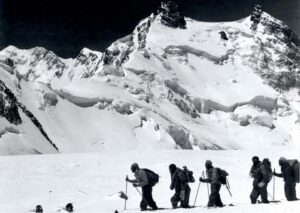In every sport, there are key moments where people seem to do the impossible, events that catapult someone’s name into the history books. In marathon swimming, one such moment came 60 years ago, on August 22, 1961, on Lake Michigan.
One of the five Great Lakes in North America, Lake Michigan borders the states of Wisconsin, Illinois, Indiana, and Michigan. The vast lake has a total surface area of 58,030 sq km, a maximum width of 190km, and a maximum length of 494km.
The 60th anniversary of Ted Erikson’s remarkable swim across the lake gives us an opportunity to relive this landmark event and delve into the history of marathon swimming.

Ted Erikson battled waves, wind, and cold water on his long swim from Chicago. Photo: Chicago Tribune Archive
Even before 1961, several swimmers tried to make the 50km across Lake Michigan from Chicago to Michigan City. In the late 1950s, Joe Griffiths attempted it four times. After years of huge waves, seiches (standing waves that can form in an enclosed body of water), storms, and relentless currents, his fourth attempt sent him to hospital. “I’ll never talk about crossing that lake again,” he declared.
Around the same time, Harry Briggs stubbornly attempted the same route. In 1960, after his third try, he gave up. Writing about the ordeal, he noted that “a rare degree of cooperation from nature” would be required for anyone to cross the lake. The challenge was not just the distance and the waves. The temperature of these big northern lakes was frigid, even at the end of August, when these swims often took place. No one wore wetsuits.
Ted Erikson tackles Lake Michigan
Jim “The Courtesy Man” Moran (a billionaire car dealer and philanthropist) had sponsored Griffith’s attempts to cross the lake. When Griffiths decided against a fifth attempt, Moran offered a cash prize of $3,675 to the first person who could swim from Chicago to Michigan City. On August 21, 1961, six swimmers lined up to take on his challenge. One of them was 33-year-old Ted Erikson.
A localized storm threw up five-metre waves. By 2 am on August 22, just one swimmer remained. While everyone else had succumbed to the horrendous conditions, Erikson had battled on. During the night, the water was so rough that his support team lost sight of him for 15 panic-inducing minutes.
The wind and currents pushed him off course. In total, he swam 70km, a whopping 20km more than intended. It took 36.5 hours, but eventually, Erikson clambered onto the pier at Michigan City to a cheering crowd of over 10,000 people. He had set two world records: he was the first person to swim across Lake Michigan and had spent the longest time in the water during an endurance swim.

Ted Erikson, aged 93, prepares for a dip in Lake Michigan. Photo: David Travis
Steven Munatones, a renowned open water swimming champion and coach, put the achievement into perspective for ExplorersWeb: “Erikson’s swim lands somewhere between extraordinary and mind-boggling…At that time, swimming at these distances was just being explored by the world’s pioneering marathon swimmers.”
What makes this all the more impressive is that Erikson was completely unknown in the world of marathon swimming.
We asked Erikson about his open-water swimming experience. How had he prepared for this great swim? His answer was surprising:
“I’d always loved the water and spent almost every day swimming a mile or so,” Erikson explained. He had considered tackling long-distance swims before but the cost had always stopped him: “I had insufficient financial resources to do it on my own, the Moran contest gave me the opportunity.”
Early long-distance swimmers
The 1950s and 1960s saw a huge uptake in marathon swimming, with numerous firsts, but it was by no means the beginning of the sport. Ten-thousand-year-old Egyptian wall paintings show men swimming using what archaeologists believe to be a primitive form of breaststroke. Similarly, mosaics and paintings from Pompeii depict swimmers in the open water. The Japanese are known to have organized outdoor swimming races as far back as 36 BC, and the Romans held races in the Tiber, with crowds of people lining the banks to watch.
When discussing key events in marathon swimming, Munatones first pick is “Skyllias and Hydna swimming 14.5km in Greece in 480 BC.”
As the story goes, Skyllias and his daughter Hydna swam 14.5km to cut the anchor ropes of a Persian fleet in the Battle of Artemision. This first historical record of a marathon-length swim has proved to be quite prophetic. Women have continued to excel in marathon swimming. It is currently one of the only sports where women achieve similar or even superior results to their male counterparts.

Captain Matthew Webb was the first person to swim the English Channel. Photo: Openwaterpedia.com
Though there are earlier examples of long-distance swimming, the feat that first drew international attention occurred on August 25, 1875. Matthew Webb crossed the English Channel in 21 hours and 45 minutes. It was his second attempt at the crossing and he was determined to finish.
Covered in porpoise oil as primitive insulation, he set off in the choppy waters. He was stung by jellyfish and pushed off course multiple times. By the end, he was so exhausted that friends were getting ready to jump in and save him because his strokes were so weak and irregular. But he finished, and he returned to England as a celebrity.
In 1926, 19-year-old Gertrude Ederle became the first woman to swim the Channel. She cut a staggering seven hours off Webb’s time, and two hours from the then-current record. She finished in 14 hours and 34 minutes.

In 1926, Gertrude Ederle became the first woman to swim the English Channel. Photo: Openwaterpedia.com
The neverending cycle of new challenges
This began a pattern. Webb was the first man to swim the channel, so Ederle became the first woman. Ederle swam from France to England, so Florence Chadwick swam from England to France.
The challenge then became to complete a round trip. Antonio Abertondo was the first to swim from England to France to England with no breaks, in 1961. Not to be outdone, Ted Erikson decided he could do it faster. So in 1965, he became the second person to complete a two-way crossing and broke the speed record in the process.
As well as speed records, swimmers wanted to tackle freezing temperatures and sought out ever more dangerous bodies of water. In 1967, Erikson became the first person to complete one of the most dangerous swims possible. He swam 50 km from the Farallon Islands to the Golden Gate Bridge. This swim was not repeated for 47 years. To this day, Erikson regards it as his proudest achievement.

Lynne Cox became famous for her ability to swim in icy water. Photo: ESPN
In 1987, Lynne Cox completed her most famous swim, a 4.3 km crossing of the Bering Strait in 3°C water. Ten years later, Susie Maroney swam 150 km from Havana to Florida. The waters were so dangerous that she had to swim in a shark cage. It wasn’t until 2013 that the route was completed without a cage, by Diana Nyad. Nyad had tried for years but ultimately succeeded at age 64.
This cycle continues on almost every waterway in the world. Swimmers strive to find new routes across oceans, rivers, and lakes. Building on the successes of those who came before, swimmers continue to push boundaries. In 2019, Sarah Thomas completed the first four-way crossing of the English Channel.
An Olympic sport
Today, marathon swimming is more popular than ever. “Its inclusion in the Olympic program was the greatest catalyst for marathon swimming around the world,” Munatones told me.
First included in the 2008 Beijing Olympics, marathon swimming has gone from strength to strength. Ten-kilometer races have cropped up all over the world, garnering thousands of participants. Though very different from Webb and Erikson’s solo swims, it demonstrates the exponential growth of the sport.

Inclusion in the 2008 Olympics has led to a surge in marathon swimming around the world. Photo: Shutterstock
As new generations of swimmers take to the water, they have many things their predecessors did not. GPS trackers, accurate weather and temperature forecasts, jellyfish ointment, shark shields, and a wealth of knowledge to draw upon. The sport may have changed, but boundary-pushing records, such as Erikson’s swim across Lake Michigan, continue to inspire.






